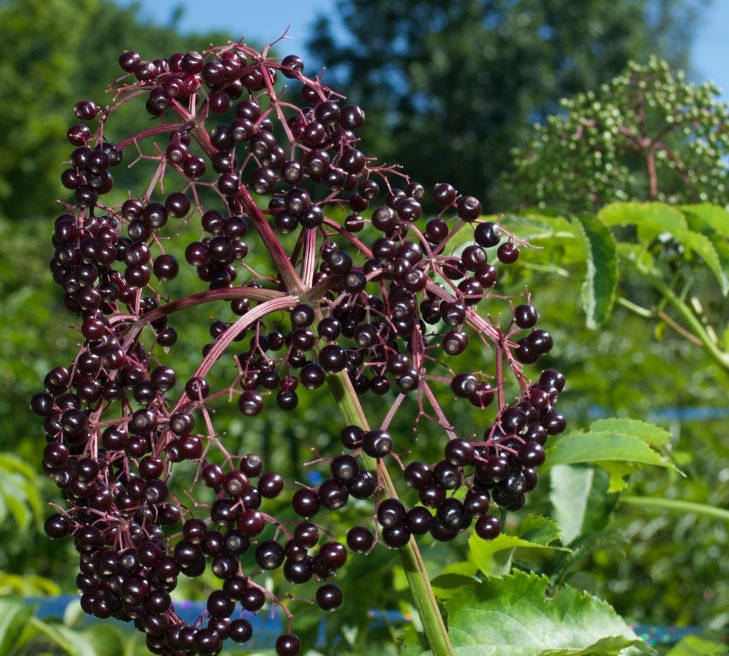Our native elderberry can be used as food, medicine and dye – it turns things pretty shades of pink, raspberry and mauve – and the bush itself looks beautiful in the landscape. People have used the shrub – by foraging for the berries or growing the bush – for centuries, but commercial farming is just beginning to take off.
Tori Jackson, a University of Maine Cooperative Extension educator based in Lisbon Falls, said the extension began researching how best to grow elderberries in 2015 after some commercial growers sought assistance. Blueberries, as a traditional Maine crop, have received a lot of attention from the extension, elderberries not so much.
So the extension is testing 12 varieties of elderberry at Highmoor Farm in Monmouth to see which ones do best.
But even before that research is complete, it has shown that the native elderberry, Sambucus canadensis, is a Zone 3 plant – meaning it will grow anywhere in Maine – that likes neutral soil and requires very little maintenance. In the wild, Jackson said, elderberries are most often found at woodland edges and beside lakes and streams, and part of the reason elderberries are being promoted as a commercial crop is that they can stand wet and otherwise marginal land that other crops can’t tolerate.
While the berries don’t taste good raw – flavors are said to range from bland to bitter – they are excellent in jam, pies and other baked goods and can be made into wine, too (remember “Arsenic and Old Lace”? Not that we are advising the addition of arsenic!). Jackson said that elderberry syrup is often used to treat influenza and other ailments, and when you see meat stamped with ink in the butcher shop, that ink is made from elderberries.
If you search online for elderberry, you’ll find a lot more references to Sambucus nigra, or black elderberry, than the native American version, but the European black elderberry does not thrive in the Maine climate. “Nigra is a little more potent for medicinal uses,” Jackson said, “but while we have not done a trial, for most people who tried to grow it, it didn’t last more than a season or two. It just can’t take our winters.”
About a decade ago, an ornamental elderberry called Black Beauty, with lacy purple foliage and pink flowers came, on the market. As often happens, the catalog descriptions of the plant were a lot more attractive than the actual plant – and many of those died off quickly, as well.
Although the native elderberries usually are not considered ornamental, they are quite attractive, growing 5 to 7 feet tall with nice-looking compound leaves. Jackson said some of the native elderberries have white flowers that are as large as basketball, while others are much smaller.
Elderberry plants have shallow roots that spread along the ground – a plant can become as much 12 feet wide over time – but when young, they don’t compete well against weeds.
Although fruit production increases if you plant two varieties, you will still get some fruit even if you have just a single plant, Jackson said. The most common varieties, she said, are Johns, Adams and Yorks.
Elderberries blossom in late June or early July, and the berries ripen – depending on the variety and season – between late August and October. As a native plant, elderberries are popular with wildlife. Pollinators love the flowers and while people aren’t partial to the raw berries, birds adore them. The bushes will produce some fruit in their second year, but won’t start producing heavily until the third or fourth year after you plant them.
They don’t need a lot of care, although pruning out some of the older branches to improve air circulation does benefit them. Good qualities aside, Jackson does foresee one problem: The spotted wing drosophila, a fruit fly that has reached Maine within the past five years. Unlike most other fruit flies, the spotted wing drosophila can lay eggs in – thus damage – fresh, healthy fruit, not just fruit that is beginning to rot.
“Elderberry is a prime target for that pest, which looks for soft fruit but doesn’t get ramped up until September,” Jackson said. “That life cycle coincides pretty well with the elderberry.”
Researchers are looking for ways to control the drosophila, including netting. Chemicals have been ruled out because the berries are an edible product too close to harvest, she said.
But even if the invasive fruit fly gets the fruit before you do, the elderberry has enough attributes, from its beauty to its usefulness for wildlife that you may want to give it a try.
Tom Atwell is a freelance writer living and gardening in Cape Elizabeth. He can be contacted at 767-2297 or at: tomatwell@me.com.
Send questions/comments to the editors.



Comments are no longer available on this story